Strategic Analysis: David Jones in the Australian Retail Market
VerifiedAdded on 2023/06/07
|9
|2355
|409
Case Study
AI Summary
This case study provides a comprehensive analysis of David Jones, an Australian department store, focusing on its strategic positioning and performance in the retail market. It examines the market size and trends, highlighting the impact of online sales and data analytics, and segments the market demographically, geographically, and psychographically. The study delves into David Jones' financial performance, noting a decline in operating profits and increased operational costs. It assesses the company's strengths, weaknesses, opportunities, and threats (SWOT), identifying its competitive advantages stemming from a strong brand image and omnichannel retailing. Strategic options, such as expanding operations and investing in technology, are considered, with recommendations emphasizing customer engagement, supply chain streamlining, and leveraging online platforms to enhance customer satisfaction and sales.

Running Head: COMPANY ANALYSIS 1
David Jones
Name
Institutional Affiliation
David Jones
Name
Institutional Affiliation
Paraphrase This Document
Need a fresh take? Get an instant paraphrase of this document with our AI Paraphraser
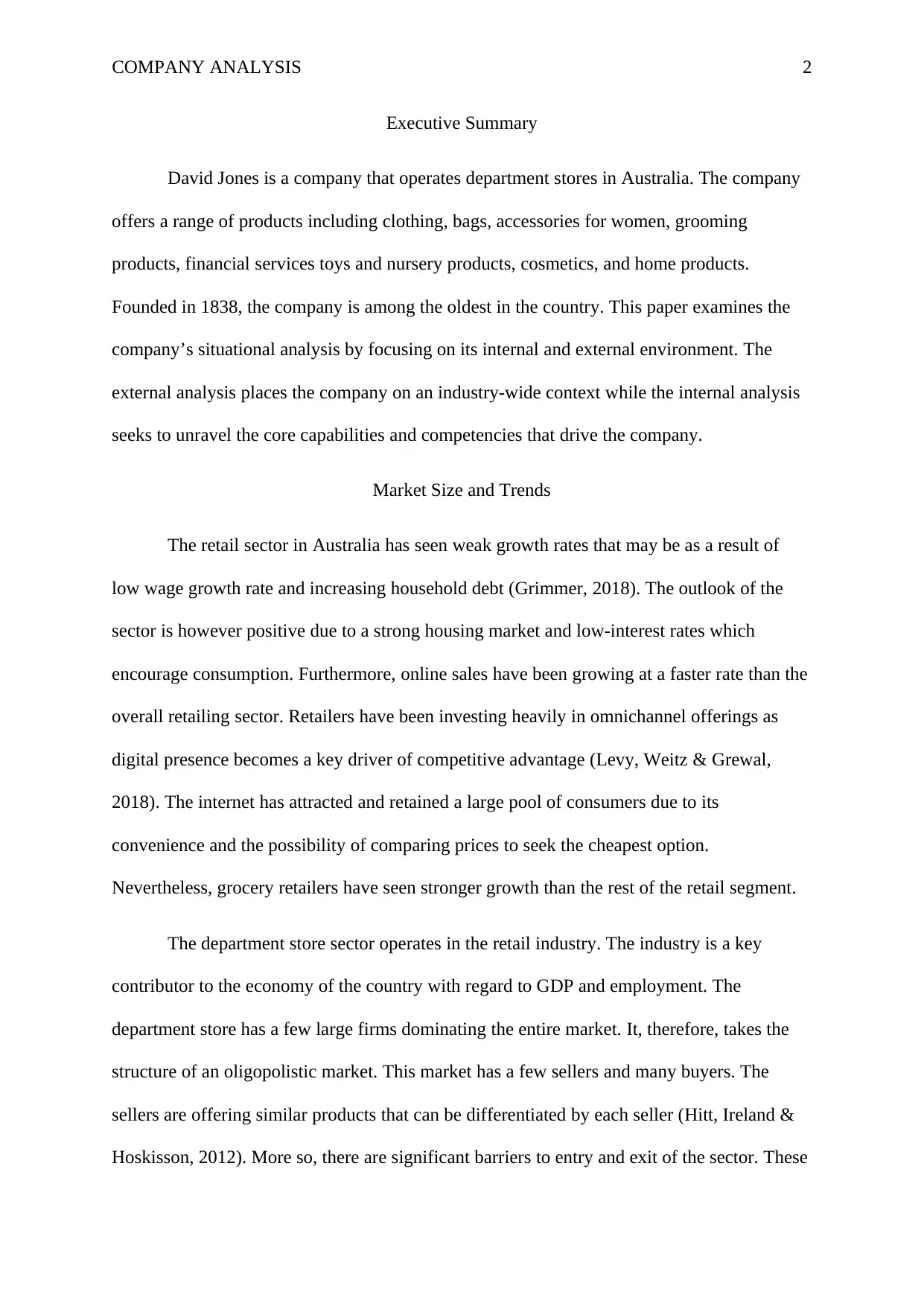
COMPANY ANALYSIS 2
Executive Summary
David Jones is a company that operates department stores in Australia. The company
offers a range of products including clothing, bags, accessories for women, grooming
products, financial services toys and nursery products, cosmetics, and home products.
Founded in 1838, the company is among the oldest in the country. This paper examines the
company’s situational analysis by focusing on its internal and external environment. The
external analysis places the company on an industry-wide context while the internal analysis
seeks to unravel the core capabilities and competencies that drive the company.
Market Size and Trends
The retail sector in Australia has seen weak growth rates that may be as a result of
low wage growth rate and increasing household debt (Grimmer, 2018). The outlook of the
sector is however positive due to a strong housing market and low-interest rates which
encourage consumption. Furthermore, online sales have been growing at a faster rate than the
overall retailing sector. Retailers have been investing heavily in omnichannel offerings as
digital presence becomes a key driver of competitive advantage (Levy, Weitz & Grewal,
2018). The internet has attracted and retained a large pool of consumers due to its
convenience and the possibility of comparing prices to seek the cheapest option.
Nevertheless, grocery retailers have seen stronger growth than the rest of the retail segment.
The department store sector operates in the retail industry. The industry is a key
contributor to the economy of the country with regard to GDP and employment. The
department store has a few large firms dominating the entire market. It, therefore, takes the
structure of an oligopolistic market. This market has a few sellers and many buyers. The
sellers are offering similar products that can be differentiated by each seller (Hitt, Ireland &
Hoskisson, 2012). More so, there are significant barriers to entry and exit of the sector. These
Executive Summary
David Jones is a company that operates department stores in Australia. The company
offers a range of products including clothing, bags, accessories for women, grooming
products, financial services toys and nursery products, cosmetics, and home products.
Founded in 1838, the company is among the oldest in the country. This paper examines the
company’s situational analysis by focusing on its internal and external environment. The
external analysis places the company on an industry-wide context while the internal analysis
seeks to unravel the core capabilities and competencies that drive the company.
Market Size and Trends
The retail sector in Australia has seen weak growth rates that may be as a result of
low wage growth rate and increasing household debt (Grimmer, 2018). The outlook of the
sector is however positive due to a strong housing market and low-interest rates which
encourage consumption. Furthermore, online sales have been growing at a faster rate than the
overall retailing sector. Retailers have been investing heavily in omnichannel offerings as
digital presence becomes a key driver of competitive advantage (Levy, Weitz & Grewal,
2018). The internet has attracted and retained a large pool of consumers due to its
convenience and the possibility of comparing prices to seek the cheapest option.
Nevertheless, grocery retailers have seen stronger growth than the rest of the retail segment.
The department store sector operates in the retail industry. The industry is a key
contributor to the economy of the country with regard to GDP and employment. The
department store has a few large firms dominating the entire market. It, therefore, takes the
structure of an oligopolistic market. This market has a few sellers and many buyers. The
sellers are offering similar products that can be differentiated by each seller (Hitt, Ireland &
Hoskisson, 2012). More so, there are significant barriers to entry and exit of the sector. These
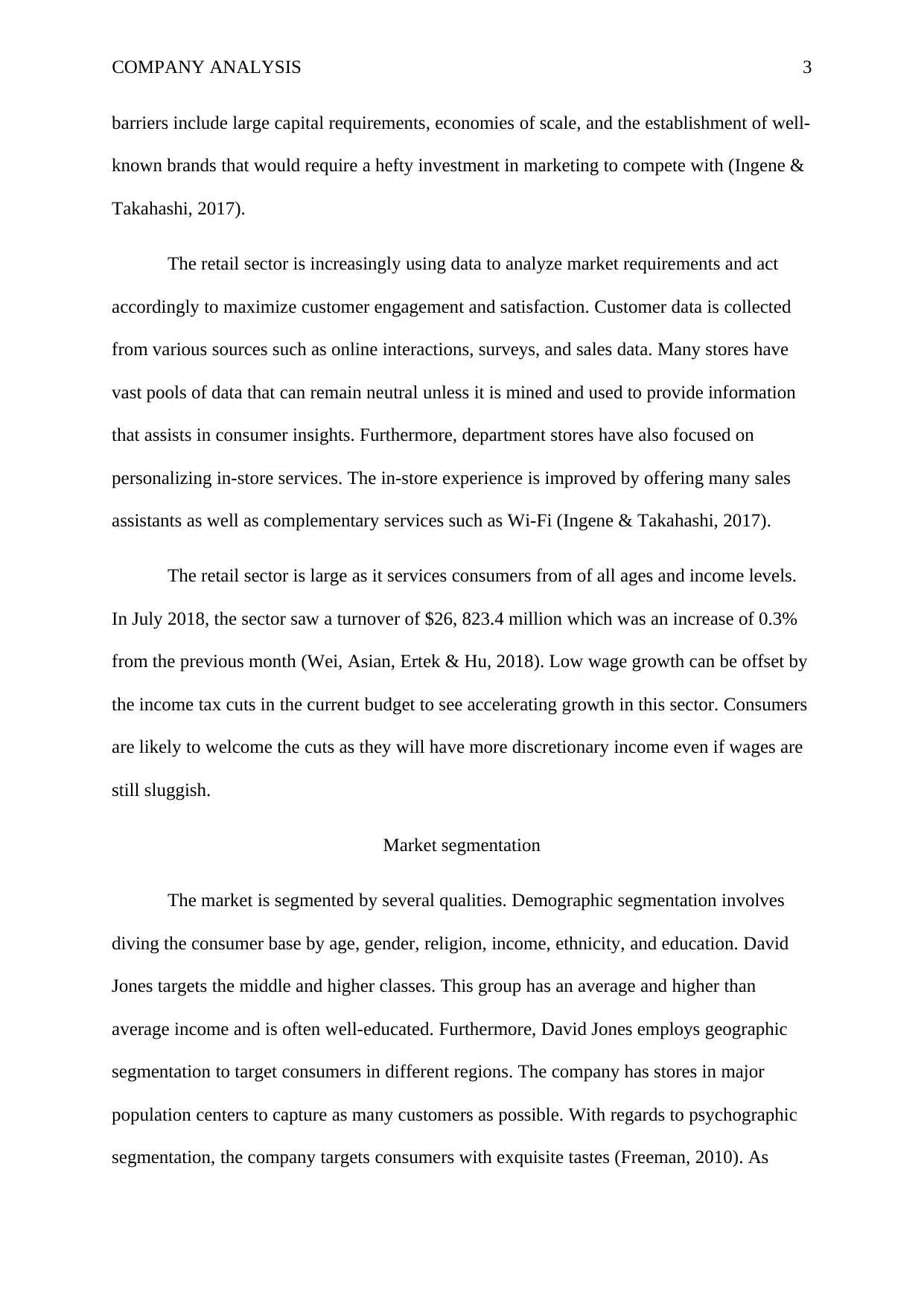
COMPANY ANALYSIS 3
barriers include large capital requirements, economies of scale, and the establishment of well-
known brands that would require a hefty investment in marketing to compete with (Ingene &
Takahashi, 2017).
The retail sector is increasingly using data to analyze market requirements and act
accordingly to maximize customer engagement and satisfaction. Customer data is collected
from various sources such as online interactions, surveys, and sales data. Many stores have
vast pools of data that can remain neutral unless it is mined and used to provide information
that assists in consumer insights. Furthermore, department stores have also focused on
personalizing in-store services. The in-store experience is improved by offering many sales
assistants as well as complementary services such as Wi-Fi (Ingene & Takahashi, 2017).
The retail sector is large as it services consumers from of all ages and income levels.
In July 2018, the sector saw a turnover of $26, 823.4 million which was an increase of 0.3%
from the previous month (Wei, Asian, Ertek & Hu, 2018). Low wage growth can be offset by
the income tax cuts in the current budget to see accelerating growth in this sector. Consumers
are likely to welcome the cuts as they will have more discretionary income even if wages are
still sluggish.
Market segmentation
The market is segmented by several qualities. Demographic segmentation involves
diving the consumer base by age, gender, religion, income, ethnicity, and education. David
Jones targets the middle and higher classes. This group has an average and higher than
average income and is often well-educated. Furthermore, David Jones employs geographic
segmentation to target consumers in different regions. The company has stores in major
population centers to capture as many customers as possible. With regards to psychographic
segmentation, the company targets consumers with exquisite tastes (Freeman, 2010). As
barriers include large capital requirements, economies of scale, and the establishment of well-
known brands that would require a hefty investment in marketing to compete with (Ingene &
Takahashi, 2017).
The retail sector is increasingly using data to analyze market requirements and act
accordingly to maximize customer engagement and satisfaction. Customer data is collected
from various sources such as online interactions, surveys, and sales data. Many stores have
vast pools of data that can remain neutral unless it is mined and used to provide information
that assists in consumer insights. Furthermore, department stores have also focused on
personalizing in-store services. The in-store experience is improved by offering many sales
assistants as well as complementary services such as Wi-Fi (Ingene & Takahashi, 2017).
The retail sector is large as it services consumers from of all ages and income levels.
In July 2018, the sector saw a turnover of $26, 823.4 million which was an increase of 0.3%
from the previous month (Wei, Asian, Ertek & Hu, 2018). Low wage growth can be offset by
the income tax cuts in the current budget to see accelerating growth in this sector. Consumers
are likely to welcome the cuts as they will have more discretionary income even if wages are
still sluggish.
Market segmentation
The market is segmented by several qualities. Demographic segmentation involves
diving the consumer base by age, gender, religion, income, ethnicity, and education. David
Jones targets the middle and higher classes. This group has an average and higher than
average income and is often well-educated. Furthermore, David Jones employs geographic
segmentation to target consumers in different regions. The company has stores in major
population centers to capture as many customers as possible. With regards to psychographic
segmentation, the company targets consumers with exquisite tastes (Freeman, 2010). As
⊘ This is a preview!⊘
Do you want full access?
Subscribe today to unlock all pages.

Trusted by 1+ million students worldwide
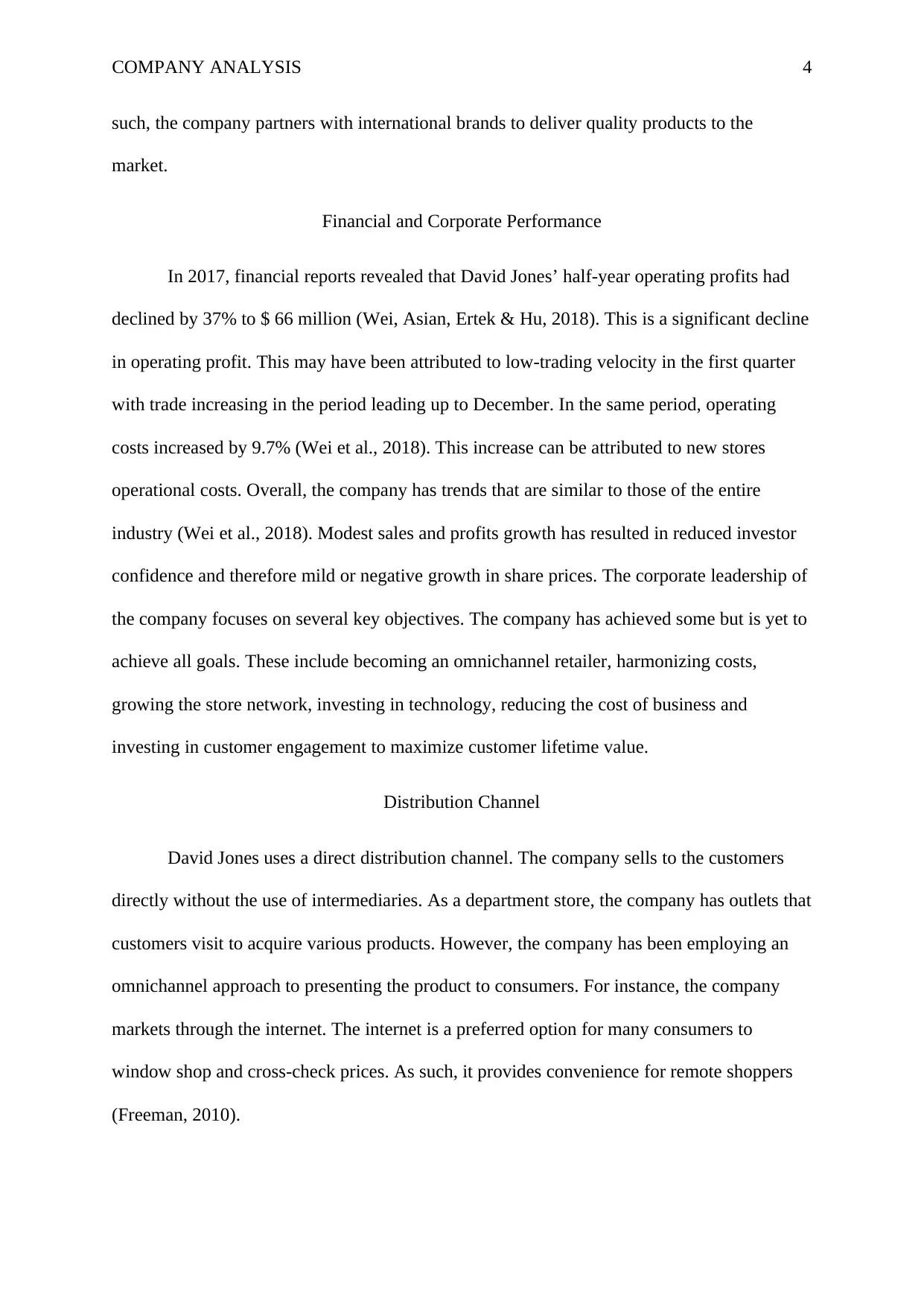
COMPANY ANALYSIS 4
such, the company partners with international brands to deliver quality products to the
market.
Financial and Corporate Performance
In 2017, financial reports revealed that David Jones’ half-year operating profits had
declined by 37% to $ 66 million (Wei, Asian, Ertek & Hu, 2018). This is a significant decline
in operating profit. This may have been attributed to low-trading velocity in the first quarter
with trade increasing in the period leading up to December. In the same period, operating
costs increased by 9.7% (Wei et al., 2018). This increase can be attributed to new stores
operational costs. Overall, the company has trends that are similar to those of the entire
industry (Wei et al., 2018). Modest sales and profits growth has resulted in reduced investor
confidence and therefore mild or negative growth in share prices. The corporate leadership of
the company focuses on several key objectives. The company has achieved some but is yet to
achieve all goals. These include becoming an omnichannel retailer, harmonizing costs,
growing the store network, investing in technology, reducing the cost of business and
investing in customer engagement to maximize customer lifetime value.
Distribution Channel
David Jones uses a direct distribution channel. The company sells to the customers
directly without the use of intermediaries. As a department store, the company has outlets that
customers visit to acquire various products. However, the company has been employing an
omnichannel approach to presenting the product to consumers. For instance, the company
markets through the internet. The internet is a preferred option for many consumers to
window shop and cross-check prices. As such, it provides convenience for remote shoppers
(Freeman, 2010).
such, the company partners with international brands to deliver quality products to the
market.
Financial and Corporate Performance
In 2017, financial reports revealed that David Jones’ half-year operating profits had
declined by 37% to $ 66 million (Wei, Asian, Ertek & Hu, 2018). This is a significant decline
in operating profit. This may have been attributed to low-trading velocity in the first quarter
with trade increasing in the period leading up to December. In the same period, operating
costs increased by 9.7% (Wei et al., 2018). This increase can be attributed to new stores
operational costs. Overall, the company has trends that are similar to those of the entire
industry (Wei et al., 2018). Modest sales and profits growth has resulted in reduced investor
confidence and therefore mild or negative growth in share prices. The corporate leadership of
the company focuses on several key objectives. The company has achieved some but is yet to
achieve all goals. These include becoming an omnichannel retailer, harmonizing costs,
growing the store network, investing in technology, reducing the cost of business and
investing in customer engagement to maximize customer lifetime value.
Distribution Channel
David Jones uses a direct distribution channel. The company sells to the customers
directly without the use of intermediaries. As a department store, the company has outlets that
customers visit to acquire various products. However, the company has been employing an
omnichannel approach to presenting the product to consumers. For instance, the company
markets through the internet. The internet is a preferred option for many consumers to
window shop and cross-check prices. As such, it provides convenience for remote shoppers
(Freeman, 2010).
Paraphrase This Document
Need a fresh take? Get an instant paraphrase of this document with our AI Paraphraser
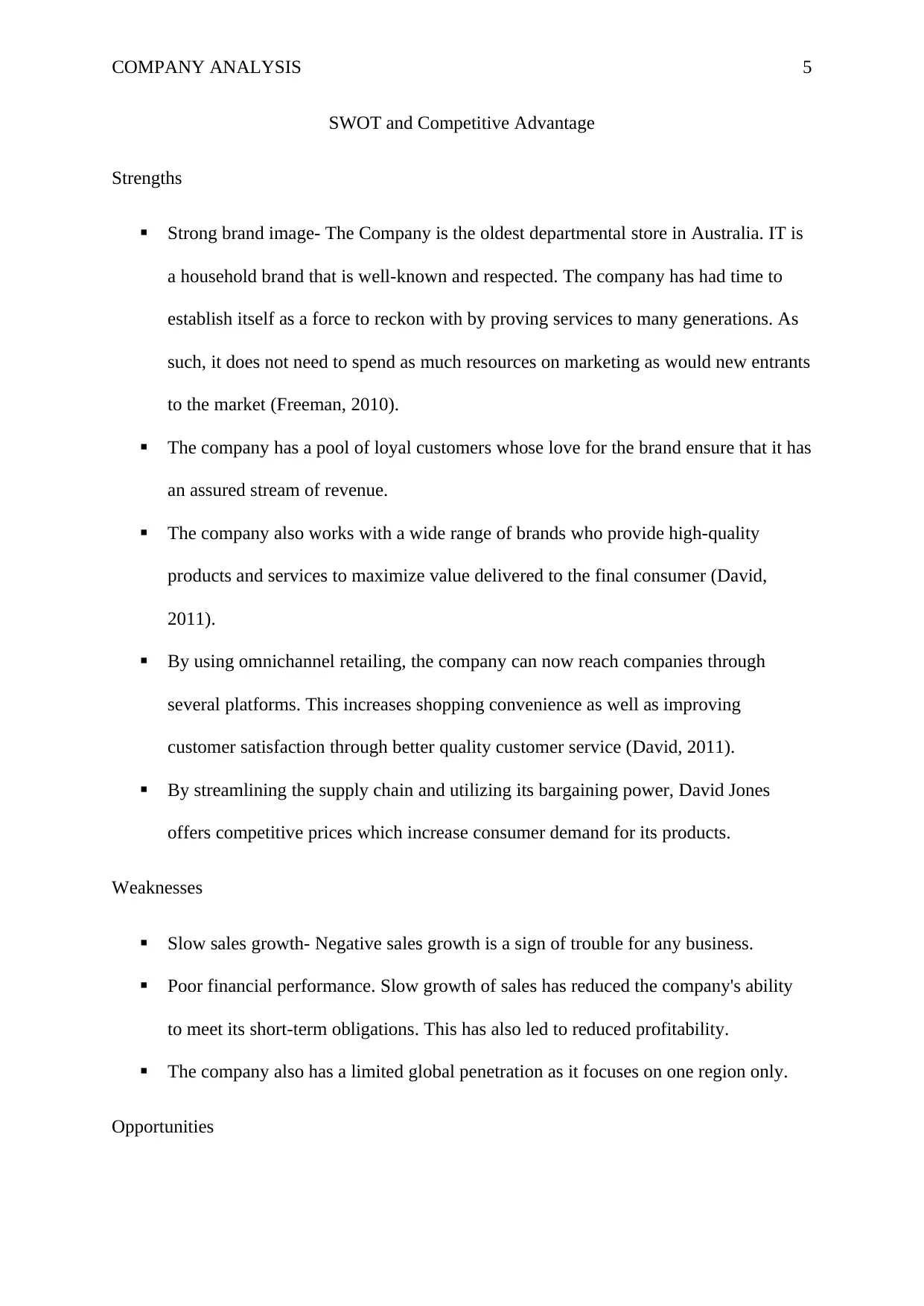
COMPANY ANALYSIS 5
SWOT and Competitive Advantage
Strengths
Strong brand image- The Company is the oldest departmental store in Australia. IT is
a household brand that is well-known and respected. The company has had time to
establish itself as a force to reckon with by proving services to many generations. As
such, it does not need to spend as much resources on marketing as would new entrants
to the market (Freeman, 2010).
The company has a pool of loyal customers whose love for the brand ensure that it has
an assured stream of revenue.
The company also works with a wide range of brands who provide high-quality
products and services to maximize value delivered to the final consumer (David,
2011).
By using omnichannel retailing, the company can now reach companies through
several platforms. This increases shopping convenience as well as improving
customer satisfaction through better quality customer service (David, 2011).
By streamlining the supply chain and utilizing its bargaining power, David Jones
offers competitive prices which increase consumer demand for its products.
Weaknesses
Slow sales growth- Negative sales growth is a sign of trouble for any business.
Poor financial performance. Slow growth of sales has reduced the company's ability
to meet its short-term obligations. This has also led to reduced profitability.
The company also has a limited global penetration as it focuses on one region only.
Opportunities
SWOT and Competitive Advantage
Strengths
Strong brand image- The Company is the oldest departmental store in Australia. IT is
a household brand that is well-known and respected. The company has had time to
establish itself as a force to reckon with by proving services to many generations. As
such, it does not need to spend as much resources on marketing as would new entrants
to the market (Freeman, 2010).
The company has a pool of loyal customers whose love for the brand ensure that it has
an assured stream of revenue.
The company also works with a wide range of brands who provide high-quality
products and services to maximize value delivered to the final consumer (David,
2011).
By using omnichannel retailing, the company can now reach companies through
several platforms. This increases shopping convenience as well as improving
customer satisfaction through better quality customer service (David, 2011).
By streamlining the supply chain and utilizing its bargaining power, David Jones
offers competitive prices which increase consumer demand for its products.
Weaknesses
Slow sales growth- Negative sales growth is a sign of trouble for any business.
Poor financial performance. Slow growth of sales has reduced the company's ability
to meet its short-term obligations. This has also led to reduced profitability.
The company also has a limited global penetration as it focuses on one region only.
Opportunities
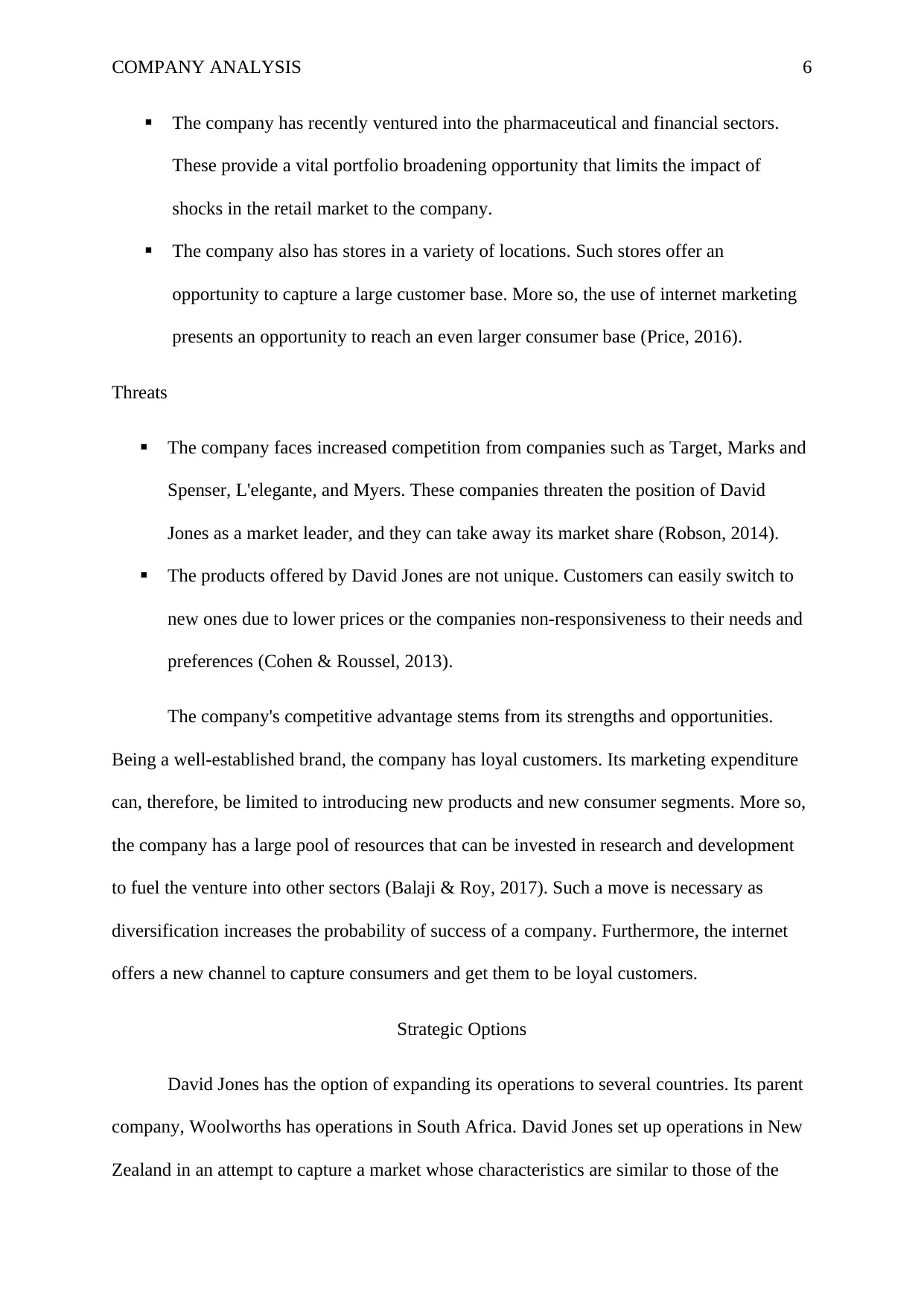
COMPANY ANALYSIS 6
The company has recently ventured into the pharmaceutical and financial sectors.
These provide a vital portfolio broadening opportunity that limits the impact of
shocks in the retail market to the company.
The company also has stores in a variety of locations. Such stores offer an
opportunity to capture a large customer base. More so, the use of internet marketing
presents an opportunity to reach an even larger consumer base (Price, 2016).
Threats
The company faces increased competition from companies such as Target, Marks and
Spenser, L'elegante, and Myers. These companies threaten the position of David
Jones as a market leader, and they can take away its market share (Robson, 2014).
The products offered by David Jones are not unique. Customers can easily switch to
new ones due to lower prices or the companies non-responsiveness to their needs and
preferences (Cohen & Roussel, 2013).
The company's competitive advantage stems from its strengths and opportunities.
Being a well-established brand, the company has loyal customers. Its marketing expenditure
can, therefore, be limited to introducing new products and new consumer segments. More so,
the company has a large pool of resources that can be invested in research and development
to fuel the venture into other sectors (Balaji & Roy, 2017). Such a move is necessary as
diversification increases the probability of success of a company. Furthermore, the internet
offers a new channel to capture consumers and get them to be loyal customers.
Strategic Options
David Jones has the option of expanding its operations to several countries. Its parent
company, Woolworths has operations in South Africa. David Jones set up operations in New
Zealand in an attempt to capture a market whose characteristics are similar to those of the
The company has recently ventured into the pharmaceutical and financial sectors.
These provide a vital portfolio broadening opportunity that limits the impact of
shocks in the retail market to the company.
The company also has stores in a variety of locations. Such stores offer an
opportunity to capture a large customer base. More so, the use of internet marketing
presents an opportunity to reach an even larger consumer base (Price, 2016).
Threats
The company faces increased competition from companies such as Target, Marks and
Spenser, L'elegante, and Myers. These companies threaten the position of David
Jones as a market leader, and they can take away its market share (Robson, 2014).
The products offered by David Jones are not unique. Customers can easily switch to
new ones due to lower prices or the companies non-responsiveness to their needs and
preferences (Cohen & Roussel, 2013).
The company's competitive advantage stems from its strengths and opportunities.
Being a well-established brand, the company has loyal customers. Its marketing expenditure
can, therefore, be limited to introducing new products and new consumer segments. More so,
the company has a large pool of resources that can be invested in research and development
to fuel the venture into other sectors (Balaji & Roy, 2017). Such a move is necessary as
diversification increases the probability of success of a company. Furthermore, the internet
offers a new channel to capture consumers and get them to be loyal customers.
Strategic Options
David Jones has the option of expanding its operations to several countries. Its parent
company, Woolworths has operations in South Africa. David Jones set up operations in New
Zealand in an attempt to capture a market whose characteristics are similar to those of the
⊘ This is a preview!⊘
Do you want full access?
Subscribe today to unlock all pages.

Trusted by 1+ million students worldwide
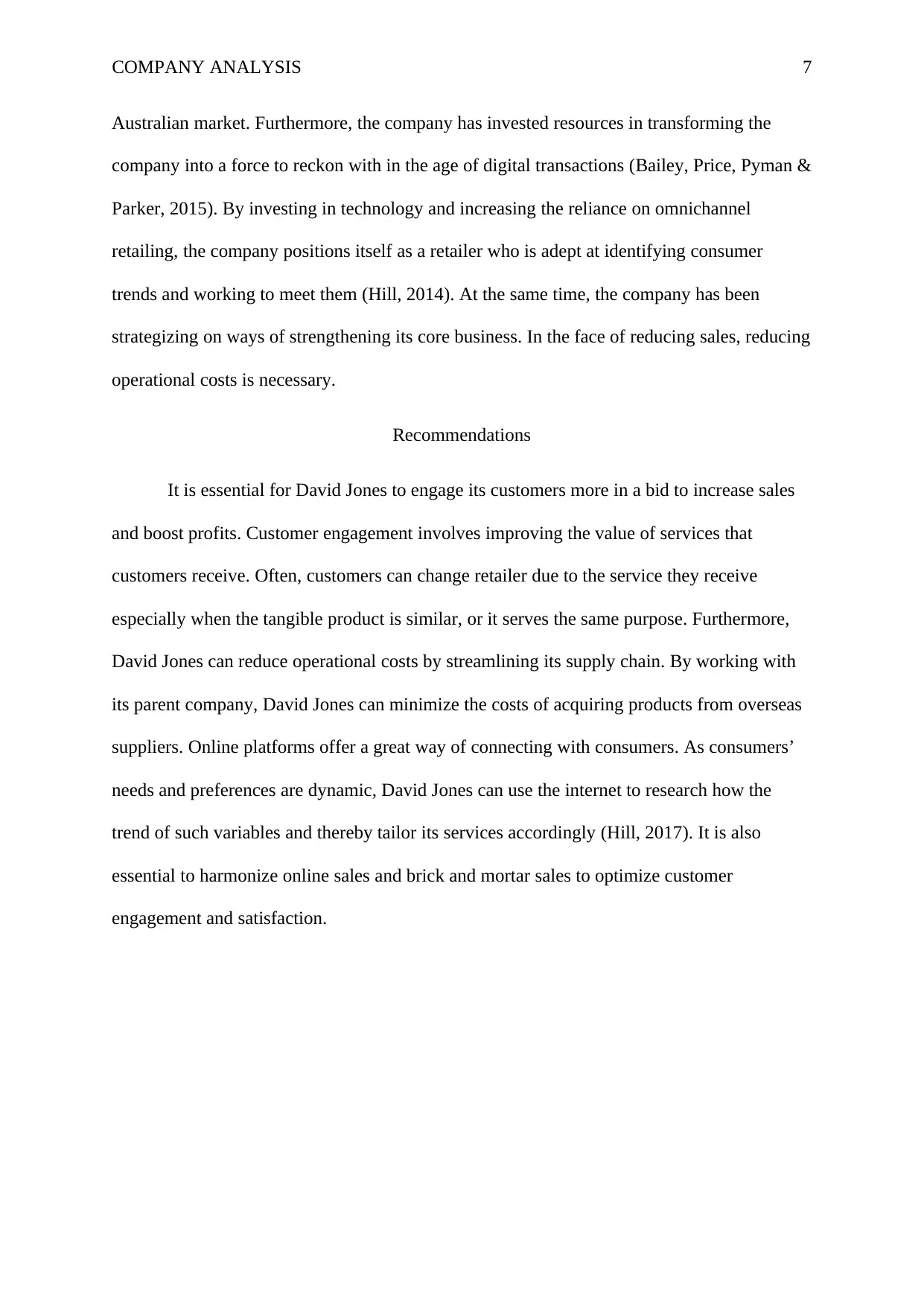
COMPANY ANALYSIS 7
Australian market. Furthermore, the company has invested resources in transforming the
company into a force to reckon with in the age of digital transactions (Bailey, Price, Pyman &
Parker, 2015). By investing in technology and increasing the reliance on omnichannel
retailing, the company positions itself as a retailer who is adept at identifying consumer
trends and working to meet them (Hill, 2014). At the same time, the company has been
strategizing on ways of strengthening its core business. In the face of reducing sales, reducing
operational costs is necessary.
Recommendations
It is essential for David Jones to engage its customers more in a bid to increase sales
and boost profits. Customer engagement involves improving the value of services that
customers receive. Often, customers can change retailer due to the service they receive
especially when the tangible product is similar, or it serves the same purpose. Furthermore,
David Jones can reduce operational costs by streamlining its supply chain. By working with
its parent company, David Jones can minimize the costs of acquiring products from overseas
suppliers. Online platforms offer a great way of connecting with consumers. As consumers’
needs and preferences are dynamic, David Jones can use the internet to research how the
trend of such variables and thereby tailor its services accordingly (Hill, 2017). It is also
essential to harmonize online sales and brick and mortar sales to optimize customer
engagement and satisfaction.
Australian market. Furthermore, the company has invested resources in transforming the
company into a force to reckon with in the age of digital transactions (Bailey, Price, Pyman &
Parker, 2015). By investing in technology and increasing the reliance on omnichannel
retailing, the company positions itself as a retailer who is adept at identifying consumer
trends and working to meet them (Hill, 2014). At the same time, the company has been
strategizing on ways of strengthening its core business. In the face of reducing sales, reducing
operational costs is necessary.
Recommendations
It is essential for David Jones to engage its customers more in a bid to increase sales
and boost profits. Customer engagement involves improving the value of services that
customers receive. Often, customers can change retailer due to the service they receive
especially when the tangible product is similar, or it serves the same purpose. Furthermore,
David Jones can reduce operational costs by streamlining its supply chain. By working with
its parent company, David Jones can minimize the costs of acquiring products from overseas
suppliers. Online platforms offer a great way of connecting with consumers. As consumers’
needs and preferences are dynamic, David Jones can use the internet to research how the
trend of such variables and thereby tailor its services accordingly (Hill, 2017). It is also
essential to harmonize online sales and brick and mortar sales to optimize customer
engagement and satisfaction.
Paraphrase This Document
Need a fresh take? Get an instant paraphrase of this document with our AI Paraphraser
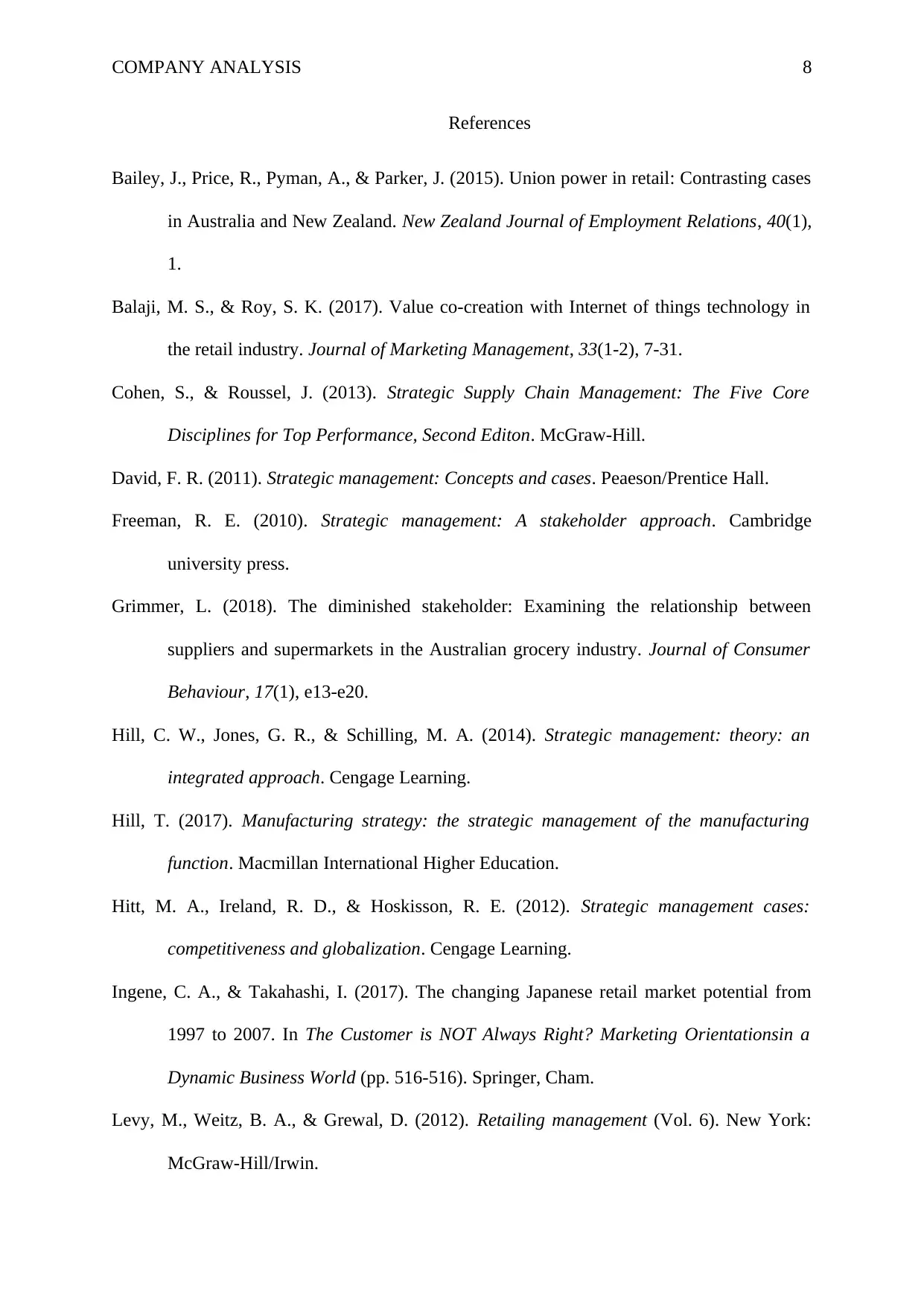
COMPANY ANALYSIS 8
References
Bailey, J., Price, R., Pyman, A., & Parker, J. (2015). Union power in retail: Contrasting cases
in Australia and New Zealand. New Zealand Journal of Employment Relations, 40(1),
1.
Balaji, M. S., & Roy, S. K. (2017). Value co-creation with Internet of things technology in
the retail industry. Journal of Marketing Management, 33(1-2), 7-31.
Cohen, S., & Roussel, J. (2013). Strategic Supply Chain Management: The Five Core
Disciplines for Top Performance, Second Editon. McGraw-Hill.
David, F. R. (2011). Strategic management: Concepts and cases. Peaeson/Prentice Hall.
Freeman, R. E. (2010). Strategic management: A stakeholder approach. Cambridge
university press.
Grimmer, L. (2018). The diminished stakeholder: Examining the relationship between
suppliers and supermarkets in the Australian grocery industry. Journal of Consumer
Behaviour, 17(1), e13-e20.
Hill, C. W., Jones, G. R., & Schilling, M. A. (2014). Strategic management: theory: an
integrated approach. Cengage Learning.
Hill, T. (2017). Manufacturing strategy: the strategic management of the manufacturing
function. Macmillan International Higher Education.
Hitt, M. A., Ireland, R. D., & Hoskisson, R. E. (2012). Strategic management cases:
competitiveness and globalization. Cengage Learning.
Ingene, C. A., & Takahashi, I. (2017). The changing Japanese retail market potential from
1997 to 2007. In The Customer is NOT Always Right? Marketing Orientationsin a
Dynamic Business World (pp. 516-516). Springer, Cham.
Levy, M., Weitz, B. A., & Grewal, D. (2012). Retailing management (Vol. 6). New York:
McGraw-Hill/Irwin.
References
Bailey, J., Price, R., Pyman, A., & Parker, J. (2015). Union power in retail: Contrasting cases
in Australia and New Zealand. New Zealand Journal of Employment Relations, 40(1),
1.
Balaji, M. S., & Roy, S. K. (2017). Value co-creation with Internet of things technology in
the retail industry. Journal of Marketing Management, 33(1-2), 7-31.
Cohen, S., & Roussel, J. (2013). Strategic Supply Chain Management: The Five Core
Disciplines for Top Performance, Second Editon. McGraw-Hill.
David, F. R. (2011). Strategic management: Concepts and cases. Peaeson/Prentice Hall.
Freeman, R. E. (2010). Strategic management: A stakeholder approach. Cambridge
university press.
Grimmer, L. (2018). The diminished stakeholder: Examining the relationship between
suppliers and supermarkets in the Australian grocery industry. Journal of Consumer
Behaviour, 17(1), e13-e20.
Hill, C. W., Jones, G. R., & Schilling, M. A. (2014). Strategic management: theory: an
integrated approach. Cengage Learning.
Hill, T. (2017). Manufacturing strategy: the strategic management of the manufacturing
function. Macmillan International Higher Education.
Hitt, M. A., Ireland, R. D., & Hoskisson, R. E. (2012). Strategic management cases:
competitiveness and globalization. Cengage Learning.
Ingene, C. A., & Takahashi, I. (2017). The changing Japanese retail market potential from
1997 to 2007. In The Customer is NOT Always Right? Marketing Orientationsin a
Dynamic Business World (pp. 516-516). Springer, Cham.
Levy, M., Weitz, B. A., & Grewal, D. (2012). Retailing management (Vol. 6). New York:
McGraw-Hill/Irwin.
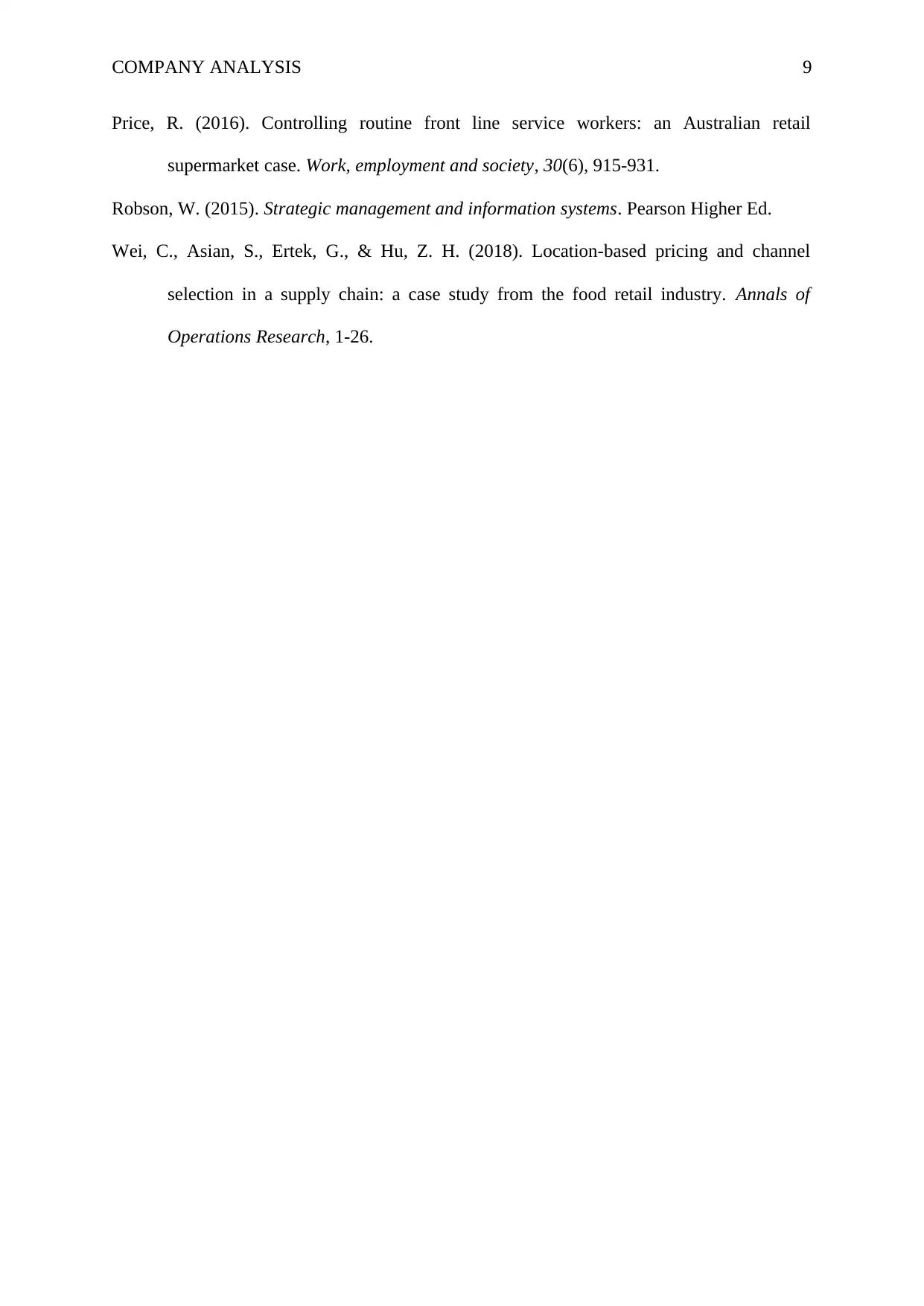
COMPANY ANALYSIS 9
Price, R. (2016). Controlling routine front line service workers: an Australian retail
supermarket case. Work, employment and society, 30(6), 915-931.
Robson, W. (2015). Strategic management and information systems. Pearson Higher Ed.
Wei, C., Asian, S., Ertek, G., & Hu, Z. H. (2018). Location-based pricing and channel
selection in a supply chain: a case study from the food retail industry. Annals of
Operations Research, 1-26.
Price, R. (2016). Controlling routine front line service workers: an Australian retail
supermarket case. Work, employment and society, 30(6), 915-931.
Robson, W. (2015). Strategic management and information systems. Pearson Higher Ed.
Wei, C., Asian, S., Ertek, G., & Hu, Z. H. (2018). Location-based pricing and channel
selection in a supply chain: a case study from the food retail industry. Annals of
Operations Research, 1-26.
⊘ This is a preview!⊘
Do you want full access?
Subscribe today to unlock all pages.

Trusted by 1+ million students worldwide
1 out of 9
Related Documents
Your All-in-One AI-Powered Toolkit for Academic Success.
+13062052269
info@desklib.com
Available 24*7 on WhatsApp / Email
![[object Object]](/_next/static/media/star-bottom.7253800d.svg)
Unlock your academic potential
Copyright © 2020–2025 A2Z Services. All Rights Reserved. Developed and managed by ZUCOL.





